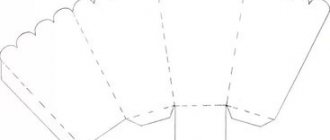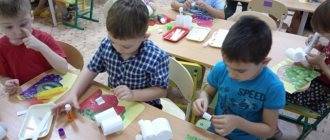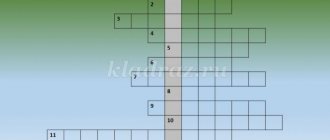…
Target.
Give children an idea of airplanes, their types, and the dependence of their structure on their purpose; to summarize: all airplanes have wings, a cabin, a cockpit, a tail, and a landing gear; practice in designing aircraft according to a model, transforming a model according to certain conditions, in planar modeling using diagrams, in coming up with your own variants of buildings; develop the ability to outline the sequence of construction of the main parts, distinguish and name geometric shapes, reason, and draw independent conclusions.
…
Material.
Construction kits, scissors.
Progress
Offer the children the task that the Cube has prepared for them: cut out geometric shapes (Fig. 38 - 39) according to the markings.
Rice. 38
Rice.
39 Working with illustrations “Helicopter”, “Airplane”.
Invite the children to find a picture with a helicopter in the upper right corner (Fig. 40) and apply geometric shapes (Fig. 38) to the image so as to cover all the details of the picture.
Rice. 40
Work with the next illustration (Fig. 41) in the same way, but invite the children to superimpose the figures (Fig. 39) on their contour images.
Rice. 41
Tips for a teacher
As you work, ask the kids whose successes you don’t have a strong opinion about to name the geometric shapes they use. Remind children to put the shapes back in envelopes when finished. Rejoice at how many geometric shapes the kids have now. Carry out games and exercises on plane modeling more often.
Working with illustrations.
Select illustrations that depict various aircraft. Consider them with your children, analyze the structure of the aircraft, determine the functional purpose (passenger, sports, military). Give the guys a riddle:
White bird
It rushes across the sky,
Dancing in the clouds
But he doesn’t flap his wings.
(Airplane)
Game "Airport".
Before the lesson starts, build an airport building with the children on shifted tables. Leave space on the tables for the runway. Take a long plate, place a short one across it and say: “This is an airplane and a pilot.” Start imitating the flight of an airplane and the sound of the engine. Let the guys join the game. Then say: “The pilots are tired, the gas in the tanks is running out - we’ll fly to the airport.” Invite the children to arrange their planes on the tarmac.
Build 2-3 different planes. Determine with your children what parts can be used to construct the chassis, interior, cabin, and wings.
Invite the children to choose and build any plane. Encourage changes and additions to designs, building “your own way,” and the desire to build several models.
Upon completion of construction, analyze the resulting structures.
Organize a construction project using Lego constructors. Show the children several design options: let the children build according to your model or come up with their own airplanes.
Game "Construction".
Offer children small toys and organize games, for example, you can build minibuses, gas stations, kiosks; decorate the airport area with trees and flowers. Take an active part in children's construction and games.
Game tasks.
Construction of aircraft of different sizes and designs (for toys and any cargo) from various building materials and construction kits.
Construction on the themes: “Little people flew on airplanes to a fairyland,” “Parade of airplanes,” “Children’s playground with airplanes,” “Carousel with airplanes.”
Game "Let's go for a visit."
Invite the children to visit old acquaintances - the animals living on the first pages of the book (Fig. 2, 3, 4, 5, 7, 8, 9, 10). Let the children look at the geometric shapes that make up the images, varying in shape, size and color.
Tips for a teacher
Expand children's understanding of airplanes; look at illustrations and toys with them; show different construction options. Promote co-creation and mutual learning. Encourage children to make up stories about their designs.
Keyword
Circuit.
The simplest diagrams of a basic aircraft model
Before moving on to complex models, let's brush up on the basics of aircraft construction. We bring to your attention the 2 easiest ways to fold an airplane.
Using the first scheme, it is easy to get a universal airplane familiar from childhood. It does not have any special takeoff and landing characteristics, but folding it is not difficult even for a child. An adult can complete the assembly in just a minute.
Don't know how to read origami diagrams? No problem - these video tutorials will allow you to quickly figure out this activity. We invite you to see with your own eyes how to make a simple paper airplane.
If even the first scheme seemed too complicated to you, use the simplified method. It allows you to get the desired result as quickly as possible.
Similar “Arrow” video:
Cardboard airplane
You will need: colored cardboard, a simple pencil, scissors, an empty matchbox, a ruler, PVA glue.
Master Class
- Cut a strip of colored cardboard 21 cm long and 1.5 cm wide.
- Cut 2 identical strips of cardboard measuring 17x4 cm, then round the corners.
- Fold the long strip in half and glue it exactly in the center of the matchbox.
- Apply glue to the top and bottom of the box and immediately glue the wings.
- Cut out the remaining parts: 2 strips measuring 5x1.5 cm; propeller and chassis.
- Cut and round the corners of one of the strips.
- Glue 2 strips to form the tail of the plane.
- Glue the propeller and landing gear to the plane.
- An airplane made of cardboard and a matchbox is ready!
Origami fighter
A three-dimensional military fighter is also being created using the origami technique. For this craft you will need a regular sheet of office paper.
Execution order:
1. Bend the sheets from both sides up and down. Intersecting diagonal lines are formed.
2. Roll the sheet horizontally. Fold part of the sheet to the left along the vertical axis. Place the right corners inside the workpiece.
3. Turn the sheet over along the horizontal line and fold a vertical strip towards the middle.
4. Bend the corners along a horizontal line. Place them inside the part. Bend the workpiece so that there is a triangle.
5. Bend the lower part of the outer layer to a horizontal line. Flip the folded portion up and split it in half. And straighten the bottom part up.
6. Straighten the folded corners and fold the workpiece along the drawn lines like this: the blue lines are a “mountain”, and the red lines are a “valley”. The top and bottom parts should move towards the horizontal line.
7. A blank similar to an arrow has formed. Flip it horizontally and you get a tail unit.
8. Fold the top corner down along a horizontal line. Bend the wing upward through the horizontal axis. Do the same with the second wing.
9. Sharpen the nose of the plane by bending the corners horizontally. Bend the entire piece to make an airplane. Raise the tail vertically and tuck the corners of the wings inside.
The origami fighter is ready to fly.
DIY PAPER AIRPLANE FOR CHILDREN
In fact, what we are doing today is origami. We will make a complex structure from a simple sheet of paper. So let’s bend it, fold it here, and in the end the plane will fly!
1. Place an A4 sheet of paper vertically in front of you. And bend the 2 side corners so that the sides meet exactly in the middle.
2. Bend the sheet along the bottom side of the resulting triangle.
3. We connect the upper side corners of the workpiece at the middle of the sheet so that a small triangle remains under the connection point, which we bent a little earlier.
4. We bend this triangle upward and press down the bent edges.
5. Turn the workpiece over and fold it in half. Connecting the sides.
6. Bend the wings in half so that the top side is level with the bottom of the workpiece.
Advice from the author of this design option is to launch the airplane easily, without effort or tension.
Then the structure will float for a long time, catching air currents with its wings.





